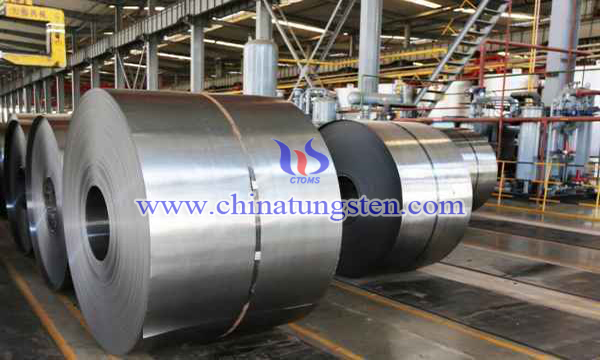Steel Bonded Tungsten Carbide Die in Cold-Rolled Silicon Iron
- Details
- Category: Tungsten Information
- Published on Friday, 13 April 2018 17:09
Steel bonded tungsten carbide dies refer to the main parts of dies (terrace dies and concave dies), which are made of steel bonded tungsten carbide. It is a kind of material made of steel as bonding material and carbide as hard phase and powder metallurgy method.

Its performance is generally between alloy tool steel and ordinary tungsten carbide. Many steel bonded tungsten carbide forged parts can be processed by ordinary turning, milling, plane and grinding after annealing. But after quenching and tempering, it will have similar hardness and good wear resistance of cermet tungsten carbide. It can also be forged, and has the characteristics of wear resistance, aviation oxidation and so on.
Although the cost of such materials is high while the heat treatment process is strict, the materials can effectively improve the service life of dies. It has better technology and economy in mass production, especially in the cold-rolled silicon steel sheet, showing its superiority.
Because the cost of tungsten carbide TW is high, the heat sleeve structure is adopted in the design of the die. The working part adopts steel bonded tungsten carbide TW. The installation part is steel 45, while the interference amount is 20%. In the process of processing, we should pay attention to the following problems:
1, Joint Clearance of Convex and Concave Die
When processing hot-rolled silicon steel sheet, the clearance between convex and concave die is generally 0.03~0.05mm. According to the relevant data, the gap between the punch and die of cold rolled silicon steel sheet is basically the same as that of the hot rolled sheet. But according to our experience in the trial production, the gap should be enlarged, and the value should be 0.06~0.08mm.
2, Machine Work of Concave Die
The hardness of steel bonded tungsten carbide TW is generally HRC35-37 under good annealing condition. It can be used for turning, milling, plane, drilling and so on. But during the cutting process, the feed rate should not be too large, and the cutting schedule should not be too fast. The cutting tool can be made of YT cemented carbide. The geometric angle of the tool should be 0 degrees or 1~ 2°, 6~ 7°, and R0.2mm~ 0.4mm. Besides, cutting fluid is not used in cutting process. Otherwise, the workpiece will be hardened rapidly, making the work to be difficult.
3, Outer Machining of Insert and Concave Die
Abrasive machining towards outer circle of die and inner circle of insert can ensure the maximum contact surface of the joint surface and close combination. The process of concave die grinding is after quenching, so the hardness of grinding wheels is higher, for which silicon carbide wheel GC601V can be used. When grinding, emulsion is picked to cool down, and the depth of grinding is 0.004mm~0.006mm. The inlay sleeve and the concave die are assembled by hot pressing, and the pre stress is obtained through the interference fit between the inner hole and the outer circle.
4, The Working Part of Concave Die
After machining work in concave die, it is time for steel bonded carbide TW die machine to get quenched. Quenching should adopt vacuum quenching technology, the temperature is 1200℃, and the temperature is 500~ 520℃. Groove machining is cut by wire cutting. When cutting, it should be divided into 2 times to avoid carbonization and crack. The first cutting margin is larger, and the allowance for the two-time cutting is smaller. After the cutting is completed, the tempering temperature should be low, and the tempering temperature is 250~ 270℃.
It has been proved that the cold punching die made with steel bonded tungsten carbide TW is not only better in the processing of cold rolled silicon steel plate, but also by 10~15 times more than before. The service life of the mold is greatly improved, and good economic benefits have been achieved. Vacuum quenching process should be adopted, with a temperature of 1200℃. Then it is time to high temperature tempering, tempering temperature is 500~ 520℃.
- Tungsten Carbide Manufacturer & Supplier, Chinatungsten Online: tungsten-carbide.com.cn
- Tungsten News & Prices of China Tungsten Industry Association: www.ctia.com.cn
- Molybdenum News & Price: news.molybdenum.com.cn
- Tel.: 86 592 5129696; Fax: 86 592 5129797; Email: sales@chinatungsten.com



 sales@chinatungsten.com
sales@chinatungsten.com